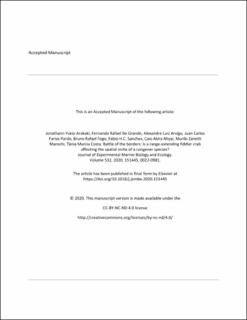| dc.contributor.author | Arakaki, Jonathann Yukio | |
| dc.contributor.author | De Grande, Fernando Rafael | |
| dc.contributor.author | Arvigo, Alexandre Luiz | |
| dc.contributor.author | Pardo, Juan Carlos Farias | |
| dc.contributor.author | Fogo, Bruno Rafael | |
| dc.contributor.author | Sanches, Fábio HC | |
| dc.contributor.author | Miyai, Caio Akira | |
| dc.contributor.author | Marochi, Murilo Zanetti | |
| dc.contributor.author | Tânia, Costa | |
| dc.date.accessioned | 2021-06-01T06:32:49Z | |
| dc.date.available | 2021-06-01T06:32:49Z | |
| dc.date.created | 2020-12-20T19:55:35Z | |
| dc.date.issued | 2020 | |
| dc.identifier.citation | Journal of Experimental Marine Biology and Ecology. 2020, 532, 151445. | en_US |
| dc.identifier.issn | 0022-0981 | |
| dc.identifier.uri | https://hdl.handle.net/11250/2757124 | |
| dc.description | This in an accepted manuscript version. Embargo until August 21 2022. | en_US |
| dc.description.abstract | Climate change is drastically altering environmental conditions and resource availability. Many organisms are shifting their distribution boundaries. Fiddler crabs, for instance, are important ecosystem engineers in coastal environments that have been extending their distribution range poleward. In this study, we evaluated the influence of a range-extending species,Leptuca cumulanta, which has recently overlapped the distribution of the resident species Leptuca uruguayensis. Through a set of field and laboratory experiments, we characterised the degree of territorial overlap between L.cumulantaandL. uruguayensis from the lower to upper intertidal zone in a mangrove area. We also analysed whether the presence of L. cumulantaprevents habitat choosiness or influences agonistic behaviours in L.uruguayensisin territorial fights. We found that both species overlap territories at the same level in the intertidal zone. However, we observed that both habitat choice and agonistic behaviours of L.uruguayensis were unresponsive to the presence of L.cumulanta. The low interference between recent hetero-specific neighbours sharing the same space supports coexistence of fiddler crabs L. uruguayensis and L. cumulanta in the early stage of overlapping | en_US |
| dc.language.iso | eng | en_US |
| dc.publisher | Elsevier | en_US |
| dc.relation.uri | https://doi.org/10.1016/j.jembe.2020.151445 | |
| dc.rights | Attribution-NonCommercial-NoDerivatives 4.0 Internasjonal | * |
| dc.rights.uri | http://creativecommons.org/licenses/by-nc-nd/4.0/deed.no | * |
| dc.title | Battle of the borders: Is a range-extending fiddler crab affecting the spatial niche of a congener species? | en_US |
| dc.type | Peer reviewed | en_US |
| dc.type | Journal article | en_US |
| dc.description.version | acceptedVersion | en_US |
| dc.rights.holder | © 2020 | en_US |
| dc.source.pagenumber | 9 | en_US |
| dc.source.volume | 532 | en_US |
| dc.source.journal | Journal of Experimental Marine Biology and Ecology | en_US |
| dc.identifier.doi | 10.1016/j.jembe.2020.151445 | |
| dc.identifier.cristin | 1862091 | |
| dc.source.articlenumber | 151445 | en_US |
| cristin.ispublished | true | |
| cristin.fulltext | postprint | |
| cristin.qualitycode | 1 | |

